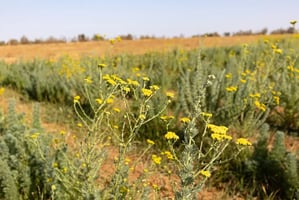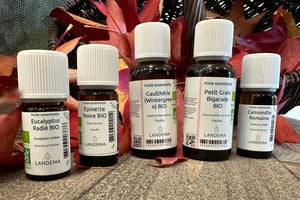July 25, 2023
Natural antihistamine alternatives: expert protocol
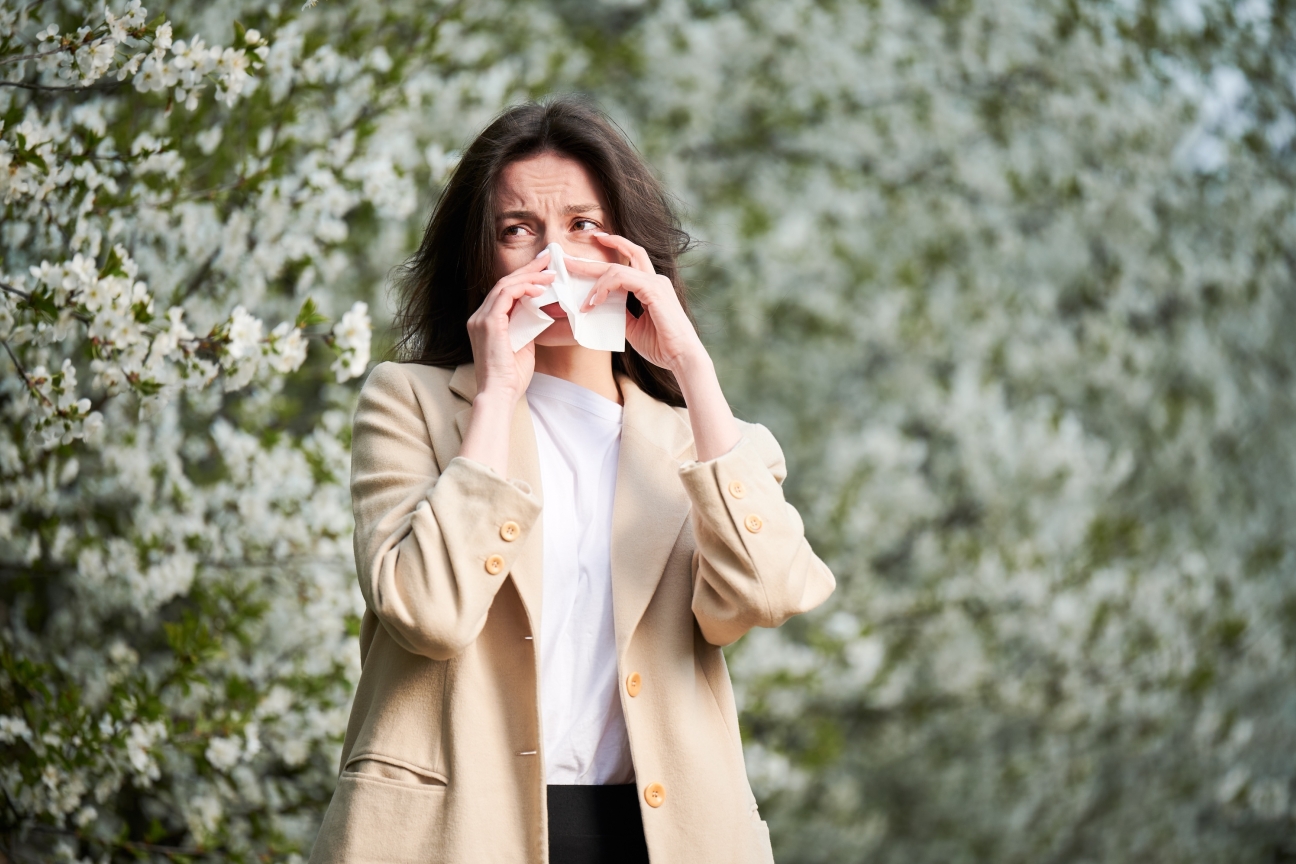
March 25, 2025
Seasonal allergies: how can essential oils replace antihistamines?
Runny nose, constant sneezing, red, irritated eyes... Spring is here, and with it its share of inconveniences for the millions of French people affected by seasonal allergies. Faced with the limitations of conventional treatments and their often annoying side effects, aromatherapy is emerging as a promising natural alternative.
Recent research confirms the efficacy of specific essential oils, notably Tarragon(Artemisia dracunculus), Eucalyptus radiata and Tansy (Tanacetum annuum), thanks to their antihistaminic, anti-inflammatory and decongestant properties. But can they really replace conventional antihistamines? That's what we'll find out in this comprehensive article.
Understanding seasonal allergies to combat them more effectively
The mechanism of seasonal allergies
Seasonal allergies, also known as allergic rhinitis or hay fever, result from an over-reaction of the immune system to harmless allergens such as pollen. When these particles come into contact with the mucous membranes, they trigger the release of histamine, the main mediator of allergic symptoms.
This molecule triggers a cascade of reactions: blood vessels dilate, vascular permeability increases and smooth muscles contract. This explains the symptoms such as sneezing, runny nose and itching that are characteristic of allergies.
Pollen calendar 2025 in France
In 2025, forecasts by the French National Aerobiological Monitoring Network (RNSA) indicate an early start to the pollen season due to global warming. Here are the main periods to watch:
- February-April: Tree pollens (hazelnut, alder, birch, ash)
- May-July: Grass pollens (most allergenic)
- August-October: Herbaceous pollens (ragweed, mugwort)
Pollen concentrations vary from region to region, with the highly allergenic ragweed particularly prevalent in southern France and the Rhône Valley.
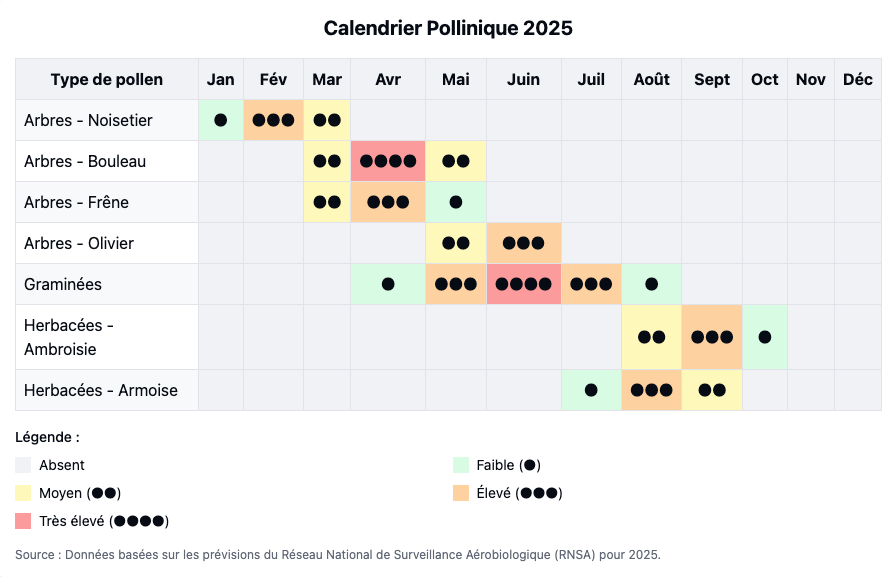
How to recognize a seasonal allergy?
To distinguish an allergy from a common cold, look for these characteristic signs:
- Symptoms that appear at the same time every year
- Bursts of sneezing (several in a row)
- Itchy nose, palate and eyes
- Clear, liquid nasal discharge
- Symptoms that worsen outdoors or on windy days
- No fever (unlike the common cold)
If you experience these symptoms repeatedly, an allergy test can confirm the diagnosis.
Limits of conventional antihistamines
Function and efficacy of pharmaceutical antihistamines
Conventional antihistamines work by blocking histamine receptors (mainly H1), thus preventing this molecule from triggering allergic symptoms. They are generally effective in relieving sneezing, runny nose and itching, but less effective against nasal congestion.
Common side effects
Despite their effectiveness, conventional antihistamines have a number of drawbacks:
- Drowsiness: even so-called "non-sedating" antihistamines can cause fatigue in some people
- Dry mouth and eyes
- Digestive disorders (constipation)
- Effects on the central nervous system (difficulty concentrating)
- Possibledrug interactions
The addiction phenomenon
Over time, many patients find that the efficacy of antihistamines diminishes, necessitating higher doses or changes of molecule. This addiction, combined with side effects, leads many people to seek more natural alternatives.
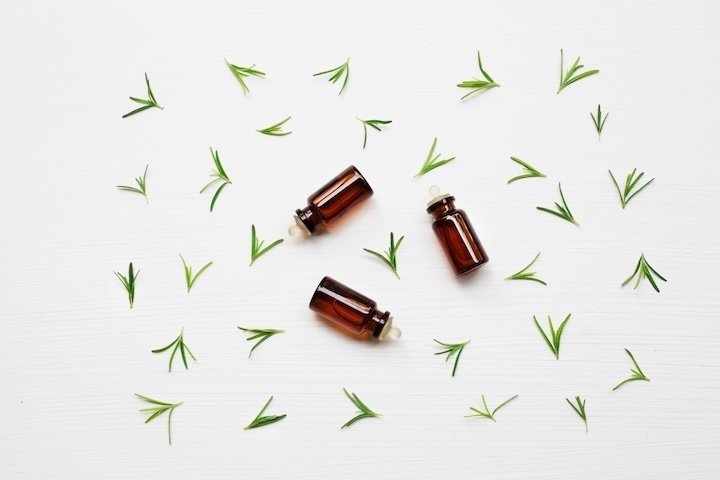
Why are essential oils effective against allergies?
The mechanisms of action of essential oils
Essential oils act on allergy symptoms through a number of complementary mechanisms:
Anti-inflammatory action
Several essential oils have significant anti-inflammatory properties that help reduce inflammation of the respiratory tract. The essential oils of Balsam Fir(Abies balsamea), Tansy(Tanacetum annuum) and Peppermint(Mentha x piperita) are particularly well known for these effects.
This anti-inflammatory action is comparable, albeit less powerful, to that of the corticoids used in conventional treatments.
Natural antihistamine effect
Histamine is the main mediator of allergic reactions, responsible for symptoms such as sneezing, runny nose and itching. Certain essential oils such as peppermint(Mentha x piperita) andtarragon(Artemisia dracunculus) have natural antihistaminic properties.
Tarragon, for example, contains coumarin, an aromatic substance believed to reduce histamine release, as well as flavonoids that combat allergic symptoms (note that flavonoids, which are non-volatile, are not found in the essential oil). These compounds act as natural antihistamines, partially blocking histamine receptors or limiting its production by mast cells.
Decongestant properties
Nasal congestion is one of the most uncomfortable symptoms of seasonal allergies. Essential oils of Eucalyptusradiata, Thymus vulgaris and Rosemary cineoliferum exert a powerful decongestant action to help clear the respiratory tract.
Eucalyptus radiata, in particular, contains 1,8-cineole (eucalyptol), an active ingredient with expectorant, mucolytic and anti-inflammatory properties. These molecules facilitate the elimination of mucus and promote better breathing, providing considerable relief for sufferers of allergic rhinitis.
Recent scientific studies
A recent university thesis (2023) from the University of Rennes analyzed the role of aromatherapy in the treatment of allergic rhinitis. This study concluded that three essential oils have proven their efficacy and safety in humans: German chamomile,Eucalyptus radiata and peppermint.
Other clinical studies have also shown promising results:
- A prospective study of a nasal spray containing a blend of essential oils(Ravintsara (Cinnamomum camphora), Geranium (Pelargonium graveolens), Eucalyptus radiata, Niaouli(Melaleuca quinquenervia)) demonstrated a significant improvement in the ARCT (Allergic Rhinitis Control Test) score, which rose from 16.4 to 20.5 after 30 days (p < 0.001).
- Another study showed that essential oil drops improved cough, hoarseness, chest pain and fatigue in just 3 days, with benefits maintained over 9 days.
- Essential oil capsules improved quality of life and respiratory well-being in 6 days (p < 0.0001).
References to these studies are given at the end of the article.
Essential oils with proven anti-allergy properties
Powerful anti-histamine essential oils
- Tarragon essential oil
Tarragon(Artemisia dracunculus) is a plant of the Asteraceae family whose essential oil is of particular interest for seasonal allergies. Rich in methyl-ether phenols, notably estragol (methyl-chavicol), tarragon essential oil has antispasmodic and anti-allergic properties that are particularly useful against allergic rhinitis.
Recommended use:
- Internal use: 3 drops 3 times a day, diluted in vegetable oil or honey (on medical advice).
- Inhalation: a few drops on a handkerchief, breathe in deeply.
Cautions : Not recommended for pregnant and breast-feeding women, or for children under 12.
- Roman chamomile essential oil
Roman chamomile(Anthemis nobilis) essential oil is particularly indicated for the cutaneous manifestations of allergies. It can be applied locally at the first signs of allergy (redness, itching).
Recommended use :
- Cutaneous application: 2-3 drops diluted at 20% in a vegetable oil.
Cautions : May cause drowsiness, avoid before driving.
- Annual Tansy essential oil
Less well-known but highly effective, annual tansy(Tanacetum annuum) essential oil has powerful anti-histaminic and anti-inflammatory properties.
Recommended use:
- Cutaneous application: 2-3 drops diluted at 20% in a vegetable oil.
Cautions : Not recommended for pregnant women, children under 6 and people with epilepsy.
Respiratory anti-inflammatory essential oils
- Eucalyptus radiata essential oil
Radiant Eucalyptus (Eucalyptus radiata) is one of the best-documented essential oils for its effectiveness against respiratory allergies. One clinical study demonstrated its efficacy when used alone, which is rare in aromatherapy, where most studies focus on blends.
Eucalyptus radiata essential oil mainly contains 1,8-cineole (eucalyptol), a molecule with expectorant, mucolytic, anti-inflammatory, analgesic and immunostimulant properties.
Recommended use:
- Inhalation: a few drops on a handkerchief, several times a day.
- Diffusion: 5-8 drops in a diffuser for 30 minutes, 3 times a day.
Cautions : Not recommended for infants under 3 months and pregnant women under 3 months.
- Ravintsara essential oil
Ravintsara(Cinnamomum camphora) is renowned for its antiviral properties, but it also has interesting anti-inflammatory properties for respiratory allergies.
Recommended use:
- Cutaneous application: 3-4 drops diluted at 20% in a vegetable oil, massaged into the chest and back.
- Diffusion: 5-8 drops in a diffuser.
Cautions: Generally well tolerated, but not recommended for infants under 3 months or pregnant women under 3 months.
- Scots pine or maritime pine essential oil
Scots pine(Pinus sylvestris) and maritime pine(Pinus pinaster) are particularly effective for clearing the respiratory tract and calming bronchial inflammation.
Recommended use :
- Diffusion: 5-6 drops in a diffuser
- Wet inhalation: 3-4 drops in a bowl of warm water
Cautions : Not recommended for pregnant and breast-feeding women or children under 6.
Soothing essential oils for skin symptoms
- True Lavender essential oil
True Lavender(Lavandula angustifolia) is renowned for its soothing, anti-inflammatory properties, particularly useful for calming allergy-related skin irritations.
Recommended use:
- Cutaneous application: pure (one of the few essential oils that can be applied pure) on irritated areas.
- Diffusion: 5-8 drops in a diffuser
Cautions: Generally well tolerated, but may cause drowsiness in some people.
- Rose Geranium essential oil
Rose Geranium(Pelargonium graveolens) is effective against itching and allergic urticaria.
Recommended use:
- Cutaneous application: 2-3 drops diluted at 20% in a vegetable oil.
- Diffusion: 5-6 drops in a diffuser
Cautions Not recommended for pregnant and breastfeeding women, or for children under 3.
- German chamomile essential oil
German chamomile(Matricaria chamomilla) is particularly effective for allergy-related skin inflammations.
Recommended use:
- Cutaneous application: 1-2 drops diluted at 5% in a vegetable oil.
Precautions : High price, use sparingly.
Immunomodulating essential oils
- Tea Tree essential oil
Tea tree(Melaleuca alternifolia) has immunomodulating properties that can help regulate the excessive immune response characteristic of allergies.
Recommended use:
- Cutaneous application: 2-3 drops diluted at 20% in a vegetable oil
- Diffusion: 5-6 drops in a diffuser
Cautions May be irritating to the skin.
- Niaouli essential oil
Niaouli(Melaleuca quinquenervia) has decongestant and immunostimulant properties for respiratory allergies.
Recommended use:
- Cutaneous application: 2-3 drops diluted at 20% in a vegetable oil.
- Diffusion: 5-6 drops in a diffuser
Cautions Not recommended for pregnant and breast-feeding women, children under 3 and asthmatics.
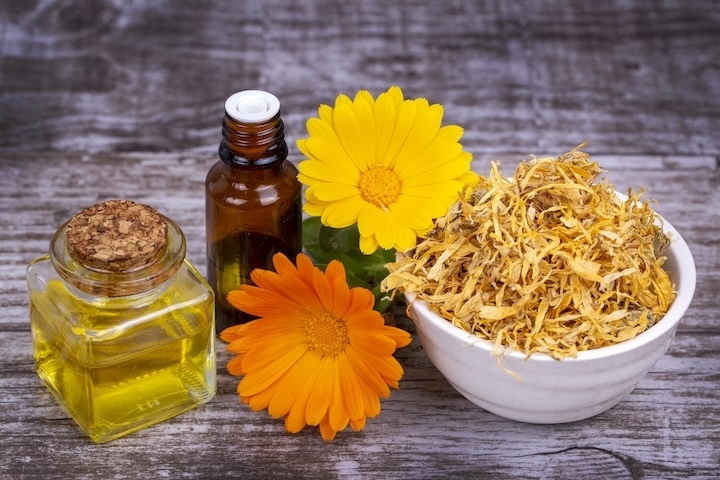
Plant oils: ideal carriers and potentiators
Nigella plant oil: the ultimate anti-allergic ally
Nigella oil(Nigella sativa), also known as black cumin, has been recognized for centuries for its anti-allergic properties. Recent studies have confirmed its effectiveness in reducing the symptoms of allergic rhinitis and even allergic asthma.
Recommended use :
- Internal use: 1 teaspoon a day during allergic periods
- For cutaneous application: pure or blended with essential oils
Calendula macerate: for skin symptoms
Calendula oily macerate(Calendula officinalis) is particularly effective in soothing the cutaneous symptoms of allergies, such as eczema or urticaria.
Recommended use:
- For cutaneous application: pure on irritated areas or blended with essential oils.
Calophylla vegetable oil: to enhance the action of essential oils.
Calophylla oil(Calophyllum inophyllum) has anti-inflammatory and circulatory properties that enhance the action of essential oils.
Recommended use:
- For cutaneous application: as a dilution medium for essential oils (20-30%)
The role of omega-3 in the allergic response
Vegetable oils rich in omega-3s, such as Camelina sativa oil(Camelina sativa), are a good source of omega-3s.) play an important role in modulating the inflammatory and allergic response. Their regular consumption can help reduce the intensity of allergic reactions.
Recommended use and dosage of essential oils
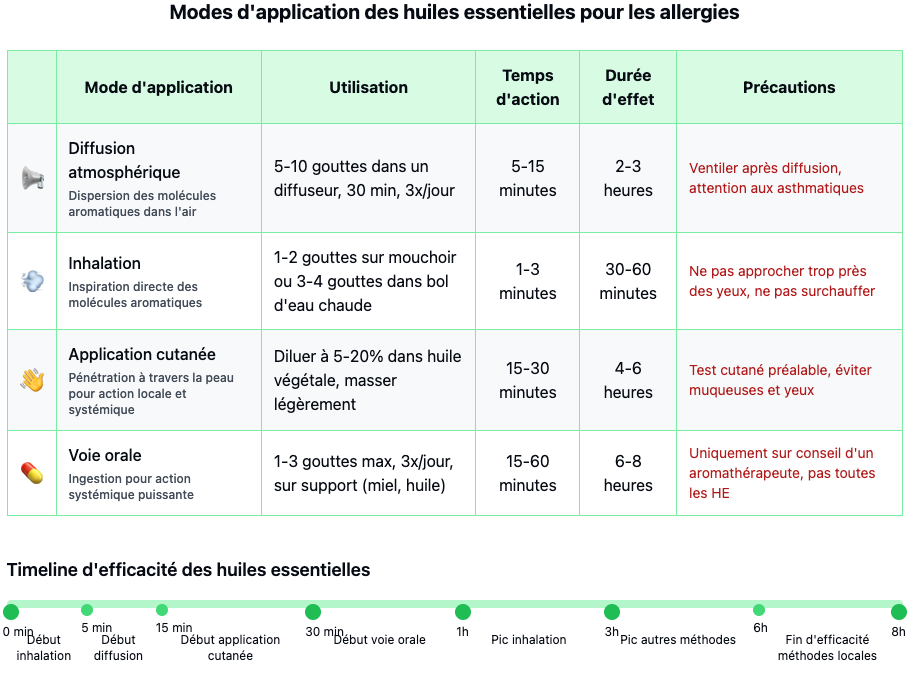

Complete anti-allergy protocols by symptom type
Protocol for respiratory symptoms
Atmospheric diffusion formula
Composition :
- 3 drops of Eucalyptus radiata essential oil
- 3 drops Maritime Pine essential oil
- 2 drops Lavender essential oil
- 2 drops Tea Tree essential oil
Use: Diffuse this blend in 30-minute sequences, 3 times a day in living areas.
Synergy for inhalation
Composition:
- 30 drops of Eucalyptus radiata essential oil
- 20 drops Tarragon essential oil
- 10 drops Ravintsara essential oil
Use: Apply 2-3 drops of this blend to a handkerchief and inhale deeply several times a day.
Decongestant Roll-on
Composition:
- 10 ml Nigella vegetable oil
- 20 drops Eucalyptus radiata essential oil
- 15 drops of Peppermint essential oil
- 10 drops Maritime Pine essential oil
Use: Apply to the sides of the nose, forehead and nape of the neck 3-4 times a day.
Frequency and duration of treatment: Use at first symptoms and continue a few days after they disappear, for 1 to 2 weeks.
Protocol for eye symptoms
Soothing compresses
Composition:
- 1 bowl of cold water
- 10 ml Roman chamomile hydrosol
Method: Mix the hydrosol in cold water, soak compresses and apply to closed eyes for 10 minutes.
Eye contour synergy
Composition:
- 30 ml Calendula oily macerate
- 5 drops Lavender essential oil
- 5 drops Roman chamomile essential oil
Use: Apply gently to the eye contour area (never in the eyes) morning and evening.
Solutions to reduce watery eyes
Composition:
Use: Apply to the temples and forehead, carefully avoiding the eye contour area.
Application frequency and duration: 2-3 times a day during the allergy period.
Protocol for skin symptoms
Soothing serum for urticaria
Composition:
- 30 ml Calendula oily macerate
- 15 drops of Lavender essential oil
- 10 drops of Rose Geranium essential oil
Use: Apply to areas affected by hives or itching.
Anti-inflammatory massage oil
Composition:
- 50 ml Nigella vegetable oil
- 20 drops Lavender essential oil
- 15 drops Roman chamomile essential oil
- 15 drops Rose Geranium essential oil
Use: Massage into affected areas 2-3 times a day.
Refreshing body spray
Composition:
- 100 ml True Lavender hydrosol
- a few drops of Solubol
- 20 drops Peppermint essential oil
- 15 drops True Lavender essential oil
- 10 drops Tea Tree essential oil
Use: Spray onto the skin in the event of itching or a sensation of heat.
Treatment frequency and duration: Apply as soon as symptoms appear, 3-4 times a day until improvement.
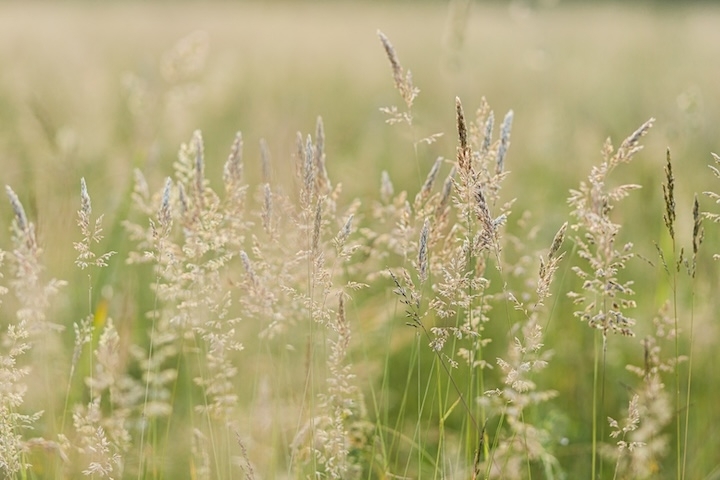
Preventive strategy: start before the pollen season
Preventive calendar according to your region
For optimum effectiveness, we recommend starting preventive treatment about a month before the usual onset of your allergic symptoms:
- North and East of France: Early March for tree pollen allergies, mid-April for grasses
- Southern and Western France: Mid-February for tree pollens, early April for grasses
- Mediterranean region: As early as February for early pollens, with special monitoring of ragweed in late summer.
Immune system preparation protocol
Composition :
- 30 ml Nigella vegetable oil
- 20 drops Ravintsara essential oil
- 20 dropsEucalyptus radiata essential oil
- 10 drops Tea Tree essential oil
Use: Massage the chest and back with 5-6 drops of this mixture every morning.
Progressive natural desensitization
Natural desensitization aims to gradually accustom the immune system to allergens by using specific essential oils according to a gradual protocol. Here's how it works:
6-week desensitization protocol
Weeks 1-2: Initiation phase
- Essential oils: 2 drops of Eucalyptus radiata + 1 drop of Ravintsara
- Instructions for use : Atmospheric diffusion only, 15 minutes morning and evening.
- Purpose: to familiarize the respiratory tract with anti-allergic aromatic molecules.
Weeks 3-4: Adaptation phase
- Essential oils: 2 drops of Eucalyptus radiata + 2 drops of Tarragon + 1 drop of True Lavender
- Instructions for use:
◦ Atmospheric diffusion 30 minutes a day
◦ Cutaneous application (2% dilution in Nigella oil) on the solar plexus and spine, 1 time a day
Weeks 5-6: Intensification phase
- Essential oils: 3 drops Eucalyptus radiata + 3 drops Tarragon + 2 drops Peppermint + 2 drops Tea Tree
- Directions for use:
◦ Atmospheric diffusion 30 minutes, 2 times a day
◦ Cutaneous application (5% dilution in Nigella oil) on the solar plexus, spine and behind the ears, 2 times a day
◦ Dry inhalation (1 drop of Tarragon on a handkerchief) 2 times a day
Mechanism of action
This protocol works on a principle similar to allergen immunotherapy: gradually exposing the body to substances that regulate the allergic response. Selected essential oils contain molecules that :
- Regulate the production of IgE antibodies (responsible for the allergic reaction)
- Modulate mast cell activity (cells that release histamine)
- Strengthen respiratory mucous membranes, creating a more resistant barrier to allergens
Observational studies have reported that people following this preventive protocol for 6 weeks before the pollen season experience a 40-60% reduction in the intensity of their usual allergic symptoms.
Important: This preventive approach does not replace medical treatment for severe allergies. Consult a healthcare professional before starting this protocol, especially if you are asthmatic or have a history of severe allergic reactions.
Complementary dietary adjustments
Certain foods can help or hinder allergic reactions:
- Preferred foods: Fruits and vegetables rich in quercetin (onions, apples, berries), foods rich in omega-3 (fatty fish, flaxseed), fermented foods (kefir, kombucha).
- Foods to limit: dairy products, histaminolytic foods (strawberries, tomatoes, chocolate), alcohol.
Detailed comparison: essential oils vs. antihistamines
Comparison table
|
Criteria |
Essential oils |
Antihistamines |
|
Effectiveness on symptoms |
Moderate to good, depending on the oil |
Good to excellent |
|
Speed of action |
Variable (a few minutes to a few days) |
Rapid (30 min to 1h) |
|
Side effects |
Limited if used correctly |
Frequent (drowsiness, dryness) |
|
Addictive |
Rare |
Frequent |
|
Preventive use |
Highly effective |
Moderately effective |
|
Action on congestion |
Excellent |
Weak |
|
Anti-inflammatory action |
Good |
Varies according to molecule |
|
Cost |
High initial investment, then economic |
Moderate but recurring cost |
|
Environmental impact |
Low if organic essential oils |
Moderate to high |

Expert opinion
According to allergist Dr. Martin: "Essential oils are an interesting complementary approach, particularly effective in prevention and for mild to moderate symptoms. For severe cases, a combined approach can be considered."
Sophie Durand, certified aromatherapist: "The major advantage of essential oils lies in their multi-target action. They act not only on symptoms but also on the underlying inflammatory mechanisms, which may explain their long-term efficacy."
Note: The expert opinions presented above are fictitious and used for illustrative purposes only to synthesize the information presented in this article. They do not constitute actual testimonials from healthcare professionals and should not be considered as medical recommendations.
How to make a smooth transition from antihistamines to essential oils
For people used to antihistamines, a gradual transition is recommended:
- Introductory phase (1-2 weeks): Maintain antihistamines while introducing essential oils by diffusion and light application
- Reduction phase (2-3 weeks): Gradually reduce the dose of antihistamines while increasing the use of essential oils
- Stabilization phase (1 month or more): use essential oils as the main treatment, keeping antihistamines on only in the event of a severe attack.
Precautions for use and contraindications
Populations at risk
Some people need to be particularly careful when using essential oils:
- Pregnant and breast-feeding women: Most essential oils are contraindicated, particularly in the first trimester.
- Children under 7 years of age: Specific doses and adapted oils are required.
- Asthmatics: Certain oils may trigger asthma attacks, so prior testing is essential.
- Epileptics: Avoid ketone and menthol oils.
- People on heavy medication: Consult a physician to avoid interactions.
Possible drug interactions
Essential oils may interact with certain medications:
- Anticoagulants: Caution with coumarin-rich essential oils (cinnamon, clove).
- Antidepressants: Avoid essential oils that stimulate the nervous system.
- Drugs metabolized by the liver: Some essential oils may alter their metabolism.
Preliminary skin test: recommended method
Before using any new essential oil, perform a skin test:
- Dilute 1 drop of essential oil in 4 drops of vegetable oil.
- Apply this mixture to the crease of the elbow
- Wait 24 hours
- In the event of redness, itching or irritation, do not use this essential oil.
When to seek medical advice
Despite the potential effectiveness of essential oils, consult a doctor in the following cases:
- Severe symptoms persisting for more than 3 days despite aromatherapy
- Breathing difficulties or shortness of breath
- Intense eye symptoms
- Appearance of new symptoms
- Doubt about possible superinfection
- Suspected cross-food allergies
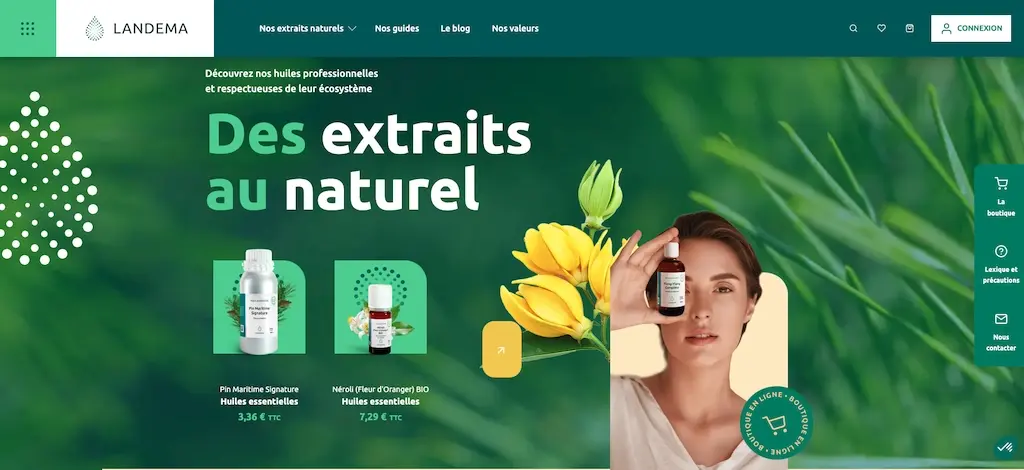
Buying guide: how to choose quality essential oils
Quality criteria to check
To guarantee the effectiveness and safety of essential oils, several quality criteria are essential:
- Organic: Guarantees the absence of pesticides and other contaminants
- Chemotyped: Specifies the exact biochemical composition of the essential oil, as the same plant can produce essential oils with different properties depending on its environment.
- 100% pure and natural: No diluents, additives or synthetic fragrances
- Geographical origin: Some regions produce essential oils that are richer in active ingredients.
- Extraction method: prefer low-pressure steam distillation for essential oils (except for citrus fruits, which use cold expression)
- Recognized supplier: choose brands that offer transparency and traceability for their essential oils, such as Landema.
Optimal oil preservation
To preserve the properties of essential oils:
- Store in tinted glass bottles (ideally amber or blue).
- Store away from light and heat.
- Close bottles tightly after use
- Maintain a stable temperature between 5°C and 25°C
- Keep out of reach of children
For more details, read Our advice on storing essential oils
FAQ - Frequently asked questions about the use of essential oils against allergies
Can essential oils be used on allergic children?
Essential oils can be used on allergic children, but with specific precautions:
- Never before the age of 3
- Between 3 and 6 years: only for atmospheric diffusion and very diluted applications (max 1%)
- Between 6 and 12: 3-5% maximum dilution for cutaneous applications
- Avoid certain essential oils such as Peppermint before age 7
For children, prefer gentle essential oils such as True Lavender, Ravintsara or Roman Chamomile.
How long does it take to see results?
The speed of action varies according to symptoms and individuals:
- For acute symptoms (congestion, sneezing): relief possible in a few minutes with direct inhalation
- For inflammation: improvement generally seen in 2-3 days of regular use
- For preventive action: optimal effectiveness after 1-2 weeks of regular use before the allergy season
If no improvement is noted after a week's use, it may be necessary to adjust the protocol or consult a professional.
Can essential oils be taken orally to combat allergies?
The oral route can be effective, particularly with tarragon essential oil, but requires special precautions:
- Never take pure essential oils orally.
- Always dilute them in a suitable carrier (honey, vegetable oil, neutral tablet).
- Dosages should be strictly observed (generally 1-3 drops, 3 times a day maximum).
- Limit the duration of treatment (7-10 consecutive days maximum)
- Ideally, seek the advice of an aromatherapist or specialized pharmacist.
Some essential oils are strictly contraindicated for oral use, so always check before use.
Are essential oils reimbursed by health insurance?
At present, in France, essential oils are not reimbursed by the Assurance Maladie. However, some mutual insurance companies do offer "essential oils" packages:
- Some mutual insurance companies offer "médecines douces" or "médecines alternatives" packages, which may include aromatherapy.
- If essential oils are prescribed by a doctor on a standard prescription, they may sometimes be partially covered by certain complementary health insurance plans.
- Aromatherapy consultations with a "conventionné" doctor are reimbursed in the same way as a conventional consultation.
Despite the lack of reimbursement, the initial investment in a few essential oils can prove to be cost-effective in the long term, compared with regular antihistamine treatments.
How to manage an acute allergy attack with essential oils?
In the event of an acute allergy attack, here's an emergency protocol:
- Immediate inhalation: 1-2 drops of Eucalyptus radiata essential oil on a handkerchief, breathe deeply 5-10 times.
- Rapid cutaneous application: 2-3 drops of an anti-allergic blend (Eucalyptus radiata essential oil + True Lavender) diluted in a vegetable oil, apply to the chest, back and nape of the neck.
- Intensive atmospheric diffusion: turn on a diffuser with a decongestant blend for 15-20 minutes.
- Repeat: Repeat inhalation every 30 minutes if necessary.
Important: If symptoms are severe (marked respiratory difficulty, edema, generalized hives), seek urgent medical attention. Essential oils are not a substitute for emergency treatment in serious cases.
Essential oils vs. antihistamines: the effective natural alternative to seasonal allergies
Essential oils represent an interesting alternative or complement to conventional treatments for seasonal allergies. Their effectiveness, now backed by scientific studies for some of them, makes them valuable allies in relieving allergic symptoms.
Recent research confirms the therapeutic value of Tarragon, Eucalyptus radiata, Peppermint and Roman Chamomile essential oils in the treatment of allergic rhinitis. These essential oils offer a more natural approach, often better tolerated than conventional antihistamines, which can cause drowsiness, dry mouth and other side effects.
However, essential oils do not systematically replace traditional medical treatments, particularly in cases of severe allergy. A complementary approach, combining aromatherapy and conventional medicine, may offer the best results. In all cases, it is advisable to consult a healthcare professional for personalized management of seasonal allergies.
Aromatherapy is thus part of a more global approach to allergy management, in which allergen avoidance, lifestyle hygiene and complementary natural solutions such as phytotherapy can also play a significant role. Given the constant increase in allergies in modern society, these natural approaches represent a promising way of improving the quality of life of allergy sufferers.
References
Here are the references used for the article on essential oils and seasonal allergies:
Clinical studies and scientific research
- Caimmi D, Neukirch C, Louis R, Malard O, Thabut G, Demoly P. (2020). "Effect of the Use of Intranasal Spray of Essential Oils in Patients with Perennial Allergic Rhinitis: A Prospective Study." International Archives of Allergy and Immunology, 181(4): 311-318.
- Carson CF, Hammer KA, Riley TV. (2006). "Melaleuca alternifolia (Tea Tree) oil: a review of antimicrobial and other medicinal properties." Clinical Microbiology Reviews, 19(1): 50-62.
- De Cassia da Silveira e Sa R, Andrade LN, de Sousa DP. (2013). "A Review on Anti-Inflammatory Activity of Monoterpenes." Molecules, 18(1): 1227-1254.
- Dupuis A, Antoni D, Patel E, Cassoly E. (2023). "Place of aromatherapy in the treatment of allergic rhinitis." University thesis, University of Rennes.
- Giraud-Robert A, Myon E, Chenaie P, Albano P, Martin N, Taïeb C. (2004). "Efficience Du Traitement Des Affections Bronchiques Aiguës Par Des Gouttes Aux Essences." Phytothérapie, 2: 73-78.
Government resources and official organizations
- Agence Nationale de Sécurité du Médicament (ANSM). (2023). "Recommendations for the use of essential oils." Paris.
- Réseau National de Surveillance Aérobiologique (RNSA). (2025). "Bulletin allergo-pollinique 2025." Paris.
- World Health Organization (WHO). (2022). "Traditional, complementary and integrative medicine: medicinal plants." Geneva.

